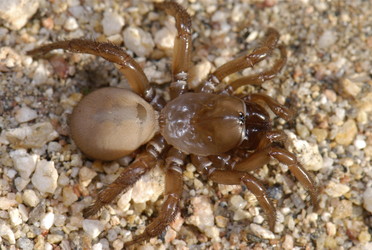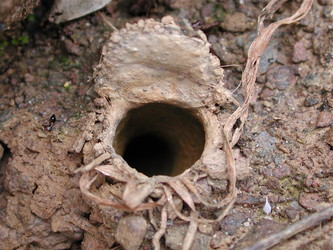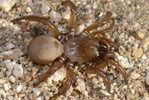Aliatypus
Marshal Hedin


This tree diagram shows the relationships between several groups of organisms.
The root of the current tree connects the organisms featured in this tree to their containing group and the rest of the Tree of Life. The basal branching point in the tree represents the ancestor of the other groups in the tree. This ancestor diversified over time into several descendent subgroups, which are represented as internal nodes and terminal taxa to the right.

You can click on the root to travel down the Tree of Life all the way to the root of all Life, and you can click on the names of descendent subgroups to travel up the Tree of Life all the way to individual species.
For more information on ToL tree formatting, please see Interpreting the Tree or Classification. To learn more about phylogenetic trees, please visit our Phylogenetic Biology pages.
close boxIntroduction
Members of this genus include small to moderately-sized mygalomorphs that build subterranean burrows with silken trapdoor entrances (Coyle, 1974; Coyle & Icenogle 1994). Of the 11 described species, 10 are restricted to California, with a single geographically-isolated species (A. isolatus) from mountains in central Arizona. These spiders are found in many different types of habitats, ranging from redwood forest to mesic oak woodland to xeric chaparral or high (Mojave) desert. Within these broader habitat types, spiders are generally found building burrows in sheltered microhabitats, including north-facing banks, ravines, shaded roadcuts, etc.
Discussion of Phylogenetic Relationships
Coyle (1974, 1994) used a combination of morphological characteristics, habitat use and trapdoor architecture to understand species-level relationships in Aliatypus. These studies suggest that A. gulosus is the most early-diverging member of the genus - male and female genitalic features support this conclusion. The remaining species fall into 2 primary species groups, including the A. californicus group and the A. erebus group. The erebus group members possess large sternal sigilla, building relatively broad trapdoors on fairly shallow slopes. Members of the californicus group possess small sternal sigilla, building more narrow trapdoors on steeper slopes. The phylogenetic placement of Aliatypus thompsoni is uncertain, as this species shares features with both species groups.
References
Coyle, F.A., 1974. Systematics of the trapdoor spider genus Aliatypus (Araneae: Antrodiaetidae). Psyche 81, 431-500.
Coyle, F.A. 1994. Cladistic analysis of the species of the trapdoor spider genus Aliatypus (Araneae, Antrodieatidae). Journal of Arachnology 22:218-224.
Coyle, F.A. and W.R. Icenogle. 1994. Natural history of the California trapdoor spider genus Aliatypus (Araneae, Antrodiaetidae). Journal of Arachnology 22:225-255.
Title Illustrations

| Scientific Name | Aliatypus erebus |
|---|---|
| Location | Butte County, CA |
| Specimen Condition | Live Specimen |
| Identified By | Marshal Hedin |
| Sex | Female |
| Collection | MCH 07_167 |
| Collector | M. Hedin, Jim Starrett & Dean Leavitt |
| Image Use |
 This media file is licensed under the Creative Commons Attribution-NonCommercial License - Version 3.0. This media file is licensed under the Creative Commons Attribution-NonCommercial License - Version 3.0.
|
| Copyright |
© Marshal Hedin

|
| Scientific Name | Aliatypus californicus |
|---|---|
| Location | Tehama County, CA |
| Acknowledgements | collecting assistance: Jim Starrett, Steve Lew, Pierre Paquin |
| Specimen Condition | trapdoor |
| Identified By | Marshal Hedin |
| Image Use |
 This media file is licensed under the Creative Commons Attribution-NonCommercial License - Version 3.0. This media file is licensed under the Creative Commons Attribution-NonCommercial License - Version 3.0.
|
| Copyright |
© Marshal Hedin

|
About This Page
Marshal Hedin

San Diego State University, San Diego, California, USA
Correspondence regarding this page should be directed to Marshal Hedin at
Page copyright © 2008 Marshal Hedin
 Page: Tree of Life
Aliatypus .
Authored by
Marshal Hedin.
The TEXT of this page is licensed under the
Creative Commons Attribution-NonCommercial License - Version 3.0. Note that images and other media
featured on this page are each governed by their own license, and they may or may not be available
for reuse. Click on an image or a media link to access the media data window, which provides the
relevant licensing information. For the general terms and conditions of ToL material reuse and
redistribution, please see the Tree of Life Copyright
Policies.
Page: Tree of Life
Aliatypus .
Authored by
Marshal Hedin.
The TEXT of this page is licensed under the
Creative Commons Attribution-NonCommercial License - Version 3.0. Note that images and other media
featured on this page are each governed by their own license, and they may or may not be available
for reuse. Click on an image or a media link to access the media data window, which provides the
relevant licensing information. For the general terms and conditions of ToL material reuse and
redistribution, please see the Tree of Life Copyright
Policies.
- First online 15 September 2008
- Content changed 15 September 2008
Citing this page:
Hedin, Marshal. 2008. Aliatypus . Version 15 September 2008 (under construction). http://tolweb.org/Aliatypus/129987/2008.09.15 in The Tree of Life Web Project, http://tolweb.org/









 Go to quick links
Go to quick search
Go to navigation for this section of the ToL site
Go to detailed links for the ToL site
Go to quick links
Go to quick search
Go to navigation for this section of the ToL site
Go to detailed links for the ToL site